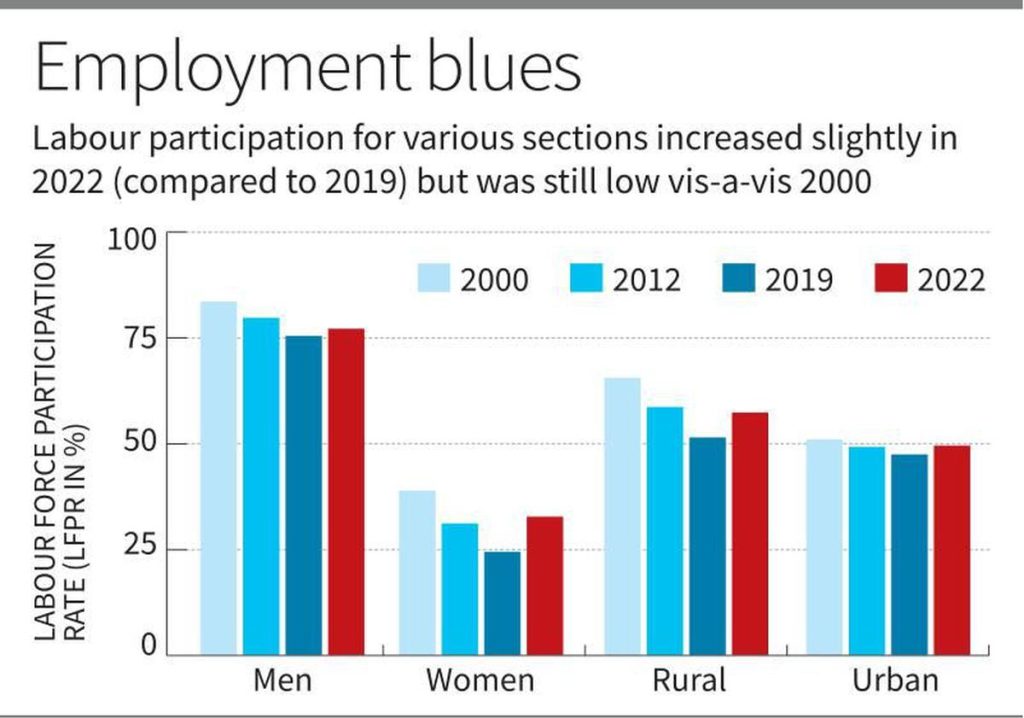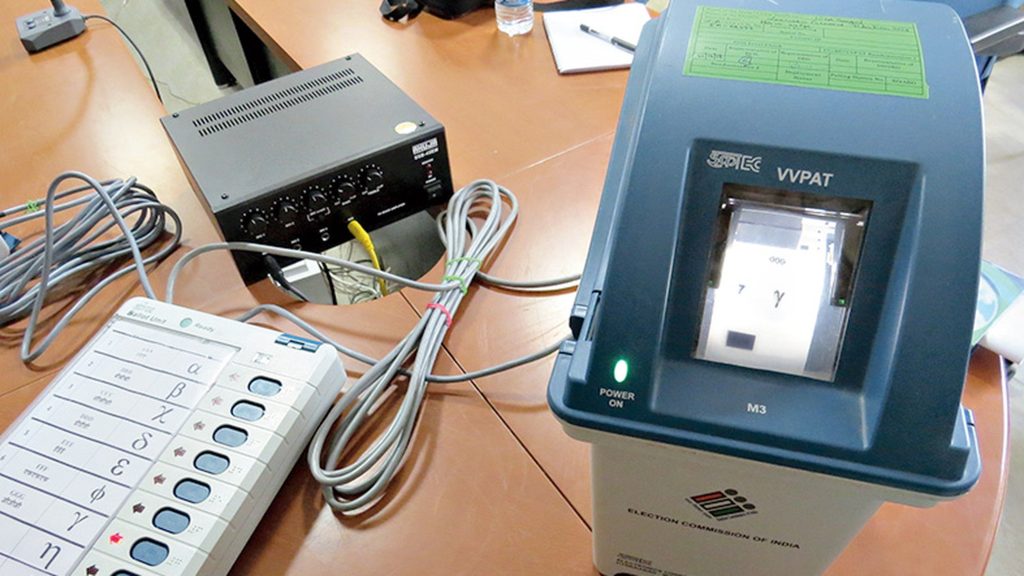CONTENTS
- Dilemma of the Unemployed Youth
- Verification of Voter Verifiable Paper Audit Trail (VVPAT) Slips
Dilemma of the Unemployed Youth
Context:
Youth unemployment presents a global challenge with significant economic, social, and political ramifications for nations at various stages of development. Recently, India has seen a surge in attention towards this issue, sparked by the release of the India Employment Report (IER) 2024 by the International Labour Organisation (ILO) and the Institute for Human Development (IHD), New Delhi on March 26, 2024.
Relevance:
GS-2- Government Policies and Interventions
GS-3
- Employment
- Growth & Development
- Skill Development
- Human Resource
Mains Question:
With reference to the recently released India Employment Report (IER) 2024 by the International Labour Organisation (ILO) and the Institute for Human Development (IHD), examine the trend of youth employment in India. What can be done to generate more employment for the country’s youth? (15 Marks, 250 Words).
More on the Report:
- The report underscores India’s demographic advantage stemming from its sizable youth populace, a trend projected to persist for at least another decade.
- However, it also draws attention to a critical challenge: the notably high and escalating rate of unemployment among young individuals, particularly those with advanced educational backgrounds, who join the workforce annually.
- This predicament has seized headlines both domestically and internationally, fueling discussions and debates in political spheres.
- Nevertheless, the issue has been subject to misinterpretation of youth unemployment rates and has become a target for politicization by various commentators and political entities, exacerbating the issue further.
Analysing the Situation Further:
The Dilemma:
- While a significant portion of the unemployed population comprises young people, they represent only a fraction of the overall youth demographic. In 2023, youths constituted 83% of India’s unemployed population.
- However, out of a total youth population of around 361 million and 664 million adults (aged 30 and above), only 5% of youths and a negligible 0.6% of adults were unemployed.
- The key point to grasp is that although it may appear that a substantial number of young individuals in the workforce, whether employed or unemployed, lack jobs, when viewed in relation to the total youth population of the country, it represents a relatively small percentage.
- Consequently, when addressing unemployment, it becomes evident that this primarily affects the youth, who often encounter greater challenges upon entering the labor market for the first time compared to experienced adults.

Relevant Statistics:
- The surplus of young laborers has masked a notable increase in job opportunities over the recent decade compared to the preceding one: Between 2012 and 2023 (the recent decade), a significant number of jobs were generated for young people compared to the period from 2000 to 2012 (the previous decade).
- Nonetheless, this positive trend was overshadowed by a substantial surge in the number of young individuals joining the labor force in the recent decade. This influx in the youth labor force contributed to an uptick in their unemployment figures and rate.
- To be specific, during the recent decade, nearly twelve times more jobs were created for young individuals (7.9 million) compared to the previous decade (0.7 million). However, the increase in the youth labor force was substantially higher in the recent decade (16.1 million) than in the previous one (1.6 million).
- Consequently, the number of unemployed young people surged more than eightfold in the recent decade (8.2 million) compared to the earlier one (0.9 million), resulting in a rise in the youth unemployment rate from 6% in 2012 to 10% in 2023.
Examining the Trends:
- The substantial increase in the proportion of young individuals with graduate and higher educational qualifications over recent decades is undoubtedly a positive development. However, this trend has also contributed to a simultaneous rise in their unemployment rate, despite the expansion of job opportunities.
- This phenomenon could stem from a mismatch between skills or an escalation in their expectations and aspirations. To delve deeper, let’s examine the trends.
- In 2000, merely 5% of young people possessed graduate or higher qualifications. By 2023, this figure surged to 20%, marking a significant leap.
- During the preceding decade, 7.6 million highly qualified young individuals entered the job market. In contrast, in the recent decade, this number skyrocketed to 24.6 million.
- However, here lies the crux: only 6.5 million secured employment in the former period, whereas 17.5 million found jobs in the latter.
- One might assume that the increase in job opportunities for highly qualified young individuals is a positive development. However, the number of unemployed graduates also surged, escalating from 1.2 million to 7.2 million. Moreover, their unemployment rate surged from 19.9% in 2012 to 28% in 2023.
- Hence, despite the recent surge in job creation for highly qualified young individuals, their unemployment rate continues to ascend.
- This could be attributed to various factors such as an oversupply of highly qualified individuals for the relatively fewer available jobs, a mismatch between their skills and employers’ requirements, or the discrepancy between the jobs available and their expectations and aspirations.
Demand for White-Collar Jobs:
- The ILO-IHD report brought attention to the fact that educated youth, irrespective of gender, aspire towards stable white-collar positions.
- Although the economy is generating jobs, it falls short in providing an adequate number of secure, well-paying public sector or white-collar positions desired by highly educated youths.
- Furthermore, rapid technological advancements have influenced the demand for skills and certain types of employment.
Shortcomings of Labour Market Surveys:
- Labour market surveys in India may not sufficiently capture data on youth engaged in emerging new forms of employment, potentially leading to inaccuracies in employment and unemployment statistics.
- This presents a challenge as evolving digital technologies are reshaping the job market, adding complexity. For instance, opportunities in the gig economy and on social media platforms like YouTube and Instagram are gaining popularity among young individuals.
- However, there has been a lack of studies to determine the prevalence of these roles, particularly given their increased prominence post the COVID-19 pandemic.
- Moreover, national labour force surveys overlook these emerging job categories due to inadequate definitions. Consequently, national labour statistics might fail to account for all existing jobs, potentially inflating the perception of unemployment among young people.
Conclusion:
The discussion highlights that while a significant number of jobs have been created for young people in the recent decade, challenges in employment persist, particularly for those with higher education levels. Given the circumstances, it’s essential to handle sensitive data, like the youth unemployment rate, with care and attention to detail. This cautious approach will enable productive discussions and debates, assisting both the government and relevant stakeholders in developing effective policies to promote youth employment.
Verification of Voter Verifiable Paper Audit Trail (VVPAT) Slips
Context:
The introduction and implementation of the Voter Verifiable Paper Audit Trail (VVPAT), a supplementary system connected to the Electronic Voting Machine (EVM), alongside the mandate of tallying VVPAT counts from five randomly selected polling booths in each Assembly constituency to cross-check with the EVM vote count, have failed to mollify critics of EVM usage in Indian elections.
Relevance:
GS2-
- Constitutional Bodies
- Government Policies and Interventions
Mains Question:
Analyse the performance of VVPATs in India since their introduction. Is there a need for a 100% recount of all VVPATs for the purpose of verification or is counting in a randomly selected polling station in each Assembly or Parliamentary constituency sufficient? Present your arguments. (15 Marks, 250 Words).
Voter Verifiable Paper Audit Trail (VVPAT):
- The Voter Verifiable Paper Audit Trail (VVPAT) was first introduced during the 2014 Lok Sabha elections in India.
- It comprises two components, namely the VVPAT Printer and the VVPAT Status Display Unit (VSDU), which are connected to the Electronic Voting Machines (EVMs).
- This system allows voters to verify that their votes are cast as intended. When a vote is cast, a slip is printed containing the candidate’s serial number, name, and symbol, which remains visible through a transparent window for 7 seconds before being automatically cut and deposited into the sealed drop box of the VVPAT.
- VVPAT is primarily used for verification purposes, with the results of EVMs being confirmed through the slips stored in the drop boxes of VVPAT machines.
- Although polling officials have access to VVPAT, voters do not. In cases of allegations of fraud or miscalculation, the paper slips from VVPAT can be considered more authoritative than EVM tallies. However, voter verification using VVPAT is typically conducted only under exceptional circumstances.
- The Election Commission of India (ECI) has the authority to order verification of votes using VVPAT slips in response to complaints.
- Currently, VVPAT slips are counted in a randomly selected polling station in each Assembly or Parliamentary constituency, depending on the type of election being held.

Arguments Raised:
- Some argue that enhancing transparency could be achieved by maintaining a machine audit trail documenting all executed commands within the system, extending beyond the recorded votes in the EVM’s ballot unit and the printed slips in the VVPATs. This would enable an audit to eliminate any potential presence of malicious code.
- Indeed, incorporating such measures could enhance the system’s resilience and be regarded as an improvement to the existing machines.
- On the other hand, some argue that the introduction of VVPATs has introduced potential vulnerabilities that were absent in the standalone nature of EVMs, along with the technical and administrative safeguards that supported the previous system.
- Addressing this concern would entail revising the safeguards to ensure that VVPAT-combined systems are as secure and dependable as standalone EVMs were.
- However, many find the criticism from various quarters, including political parties such as the Congress, advocating for a 100% recount of all VVPATs instead of the current sampling method, incomprehensible.
- They argue that only a comprehensive recount would ensure complete transparency. Consequently, the Supreme Court of India has scheduled a series of hearings regarding this demand.
How has the Performance of EVMs been?
- Despite dire warnings regarding malpractices and EVM hacking, there has been no concrete evidence of any actual tampering with EVMs thus far.
- While EVMs, like any machinery, have experienced glitches and have been promptly replaced in case of malfunctions, the assertion that they are susceptible to hacking or manipulation, despite the presence of existing technical and administrative safeguards, has been made without substantiated proof.
- Sample counting of VVPATs, conducted during both the general election in 2019 and various Assembly elections, has indicated that the discrepancy between the VVPAT recount and the EVM count has been negligible.
- Such discrepancies often stem from minor errors such as failure to delete mock polls from the machine before the voting process or inaccuracies in manually recording the final count from the machine.
Conclusion:
Boosting the recount sample size to enhance statistical significance, either by tailoring the selected number of Assemblies according to the size of each State/Union Territory or by increasing the recount sample in constituencies with narrow victory margins (e.g., less than 1% of the overall votes), could serve as potential solutions. However, demanding a full recount appears excessive and indicates a significant lack of trust in the EVM system itself.





